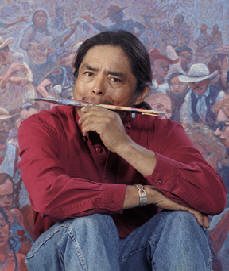At the young age of 8, I sat in awe as my elders hunched over a smooth bed of sand as the holy deities once again were given form.
There on the hogan floor, to the low drone of an ancient chant, deft fingers gnarled by years of labor, drew fine lines of colored sand from their fingertips. As the son of a very important medicine man, I knew the significance of these images as a recreation of the universal healing patterns. They dazzled my youthful eyes and carried my spirit aloft. These were very sacred undertakings I sat witness to time and again. In time, I was allowed to assist the elders draw within the bounds of an ancient template. The lengthy work was used and discarded appropriately before the afternoon. The pattern of mystery defined for me the greater mystery of its healing powers. The illness of the patient, through chants and contact, is drawn into its geometric and organic shapes.
As a professional working artist today, I am bound by very little in terms of what I can depict. But, there are images I never recreate without thinking, without quiet prayers upon my lips. There are images I do not touch because of what I was taught and gifted with. Such is the representation of the holy mandalas of the Dineh’ outside of a ceremonial settings. I would be the last to censor any attempt in pushing an envelope, yet these depictions I see so abundantly today with hefty price tags has me once again in a state of awe and shock.
In olden days, we are taught that the holy forms of the Ye’ii, (Spirit God-being) is never to be done in a casual and superficial ways. They are not even gazed upon with innocent eyes. We know that to trivialize our own spirituality in manners disrespectful of the mandalas was a great and grievous sin. For that reason, I have never tread on that sacred grounds. Some things must be kept in pure sanctity. Heaven knows, we have compromised on plenty.
We rage against desecrations upon our sacred sites, upon our images and appropriations of our spirituality, yet I feel we are the desecraters in many examples. We are not entitled to rough up the edges of our prayers, yet we do. We are not entitled to break the bounds of what we won’t allow others. We certainly are not given permission to commidify our holiness. Yet we do.
I attend many Native art markets and galleries that caters to this. I am always bothered by the commercialization—images that used to mean something to us, not just a means to another truck payment. Many times, I do ask the vendors what it means to them. Most times the answer or justifications are the same: “I had a ceremony that allows me access to and the right do sand painting, because my great grandfather was a medicine man …” I’ve never heard of one given the right to violate this sacred trust. What sort of songs and prayers allow this? My elders have always staunchly stated the reverence of this parameter.
My sand painting experiences are on Etch A Sketch these days. Meditative and temporary.
As an artist respected by my peers, I have been confided in many times by artists who used to practice this. I have never heard of one who benefitted other than financially. Most have experienced consequences of regrets. Yes, there are ex-exploiters who have since seen the image as much more than just an intricate and exotic ornament upon a wall.
One has to have been on the bed of sand, connecting with the universal healing spirits, feeling the esoteric molecular exchanges of flesh and earth and greeting rejuvenation to speak for these symbols. I have been on such a bed 16 times. Permission to desecrate was never whispered into my ears.
I also was never given permission to lecture others about what they can and cannot do. This is my take on the proliferation and commodification of our most treasured gift of maintaining balance, communing with the universe and our Mother, the Earth.
Ho zho’ na has dlii’

